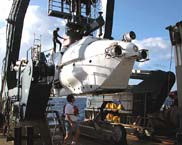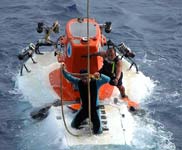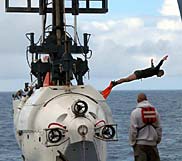|
|
||||||||||||||||||||||||||||||||||||||||||||||||||||||||||||||||||||||||||||||||||||||||||||||||||
 |
||||||||||||||||||||||||||||||||||||||||||||||||||||||||||||||||||||||||||||||||||||||||||||||||||
Imagery is my gig on this cruise. The first thing I do when I get out of the bunk in the morning is to hurry out to the working deck to take pictures of Alvin before the launch… photo documentation of the type and arrangement of instruments loaded into the sub’s “science basket.” After a quick breakfast, I rush back out to get pictures of the whole launch operation. I never get tired of watching: A group of people cluster on the back deck, coffee cups in hand, talking and joking. The mood is light… expectant. A small boat is launched to stand by near the ship’s stern. An Alvin pilot ascends the ladder and climbs down into the submersible first, followed by the two scientists who will direct the dive, observe and take notes. A round vault-like titanium door seals the three aquanauts inside and two skin divers climb atop Alvin and hold on.
Without any more ado, Alvin is hoisted off the deck by a huge arch crane mounted on the stern of the Atlantis. The submersible is suspended above the water and, when the two divers give the ‘thumbs up’ signal, Alvin is lowered into the ocean. As the sub heaves up and down in the surging water, alarmingly close to the ship’s massive stern, the divers work quickly to unhook the tail line and the heavy rope that bore the weight of Alvin. Once free, the sub drifts back and the swimmers perform their checks, diving periodically to look at the fuselage below, and to release the lines that support the science basket when the sub is above water. When all is ready, word is given to open the air filled ballast tank that keeps Alvin afloat. A spray of water erupts as air escapes and the tank fills. The orange “sail” finally plunges beneath the waves and Alvin descends, ferrying the three adventurers into the depths on their mission scientific research and discovery. Onboard Atlantis there is plenty to do. I download all of the launch snapshots from a digital camera and set to work on yesterday’s imagery. Alvin has five video cameras, mounted in various locations on its exterior that are recorded onto two
Video tapes have to be duplicated, and the gigabytes and gigabytes worth of digital still imagery has to be downloaded, filed, backed up, time-stamped, and made accessible to the scientists aboard for their review. This cruise promises a lot of stunning imagery and I can’t wait to start piecing together mosaics of digital stills showing the bizarre white carbonate structures found at the Lost City.
When the dive is over, around 3:30PM, Alvin drops its weights and returns to the surface. The sub is sighted, the ship's whistle sounds and a small boat with skin divers aboard charges out to meet it. The recovery is pretty much the reverse of the launch except that this time the divers ride Alvin back up and leap off the sub as it reaches the top of the hoist! Two swimmers help recover Alvin after a dive. They jump off before it comes aboard. |
||||||||||||||||||||||||||||||||||||||||||||||||||||||||||||||||||||||||||||||||||||||||||||||||||



